Anti-Arthritic Activities of Supercritical Carbon Dioxide Extract Derived from Radiation Mutant Perilla Frutescens Var. Crispa in Collagen Antibody-Induced Arthritis
Abstract
:1. Introduction
2. Materials and Methods
2.1. Animals
2.2. SC-CO2 Extraction
2.3. HPLC Analysis
2.4. Sample Preparation and Treatment
2.5. Collagen Antibody-Induced Arthritis
2.6. Assessment of Clinical Signs of Inflammation
2.7. Histopathological Assessement
2.8. Analysis of Neutrophils and Lymphocytes
2.9. Statistical Analysis
3. Results
3.1. Composition of SFE-M and SFE-W
3.2. Effects of SFE-W and SFE-M Treatments on the Development of RA in CAIA Model
3.3. Effects of SFE-W and SFE-M Treatments on Paw Volume in CAIA Model
3.4. Effects of SFE-W and SFE-M Treatments on Paw Thickness in CAIA Model
3.5. Effects of SFE-W and SFE-M Treatments on Arthritic Score in CAIA Model
3.6. Effects of SFE-W and SFE-M Treatments on Blood Cell Population in CAIA Model
4. Discussion
5. Conclusions
Author Contributions
Funding
Conflicts of Interest
References
- Han, D.S.; Chung, B.H.; Yoo, H.G.; Kim, Y.O.; Baek, S.H. Studies on the cytotoxicity and antitumor activity of Perilla frutescens. Korean J. Pharmacogn. 1994, 25, 249–257. [Google Scholar]
- Kim, J.Y.; Kim, J.S.; Jung, C.S.; Jin, C.B.; Ryu, J.H. Inhibitory activity of nitric oxide synthase and peroxynitrite scavenging activity of extracts of Perilla frutescens. Korean J. Pharmacogn. 2007, 38, 1–24. [Google Scholar]
- Lee, H.A.; Han, J.S. Anti-inflammatory effect of Perilla frutescens (L.) Britton var. frutescens extract in LPS-stimulated RAW 264.7 macrophage. Prev. Nutr. Food Sci. 2012, 17, 109–115. [Google Scholar] [CrossRef] [PubMed] [Green Version]
- Cho, B.O.; Park, H.Y.; Ryu, H.W.; Jin, C.H.; Choi, D.S.; Kim, D.S.; Lim, S.T.; Seo, K.I.; Byun, M.W.; Jeong, I.Y. Protective effect of Perilla frutescens cv. Chookyoupjaso mutant water extract against oxidative injury in vitro and in vivo. Food Sci. Biotechnol. 2011, 20, 1705–1711. [Google Scholar] [CrossRef]
- Choi, W.H.; Um, M.Y.; Ahn, J.Y.; Kim, S.R.; Kang, M.H.; Ha, T.Y. Acetylcholinesterase inhibitory activity and protective effect against cytotoxicity of perilla seed methanol extract. Korean J. Food Sci. Technol. 2004, 36, 1026–1031. [Google Scholar]
- Jin, C.; Park, H.C.; So, Y.; Nam, B.; Han, S.; Kim, J.B. Comparison of the anti-inflammatory activities of supercritical carbon dioxide versus ethanol extracts from leaves of Perilla frutescens Britt. Radiation mutant. Molecules 2017, 22, 311. [Google Scholar] [CrossRef] [Green Version]
- Guan, W.; Li, S.; Yan, R.; Tang, S.; Quan, C. Comparison of essential oil of clove buds extracted with supercritical carbon dioxide and other three traditional extraction methods. Food Chem. 2007, 101, 1558–1564. [Google Scholar] [CrossRef]
- Sookwong, P.; Suttiarporn, P.; Boontakham, P.; Seekhow, P.; Wangtueai, S.; Mahatheeranont, S. Simultaneous quantification of vitamin E, r-oryzanols and xanthophylls from rice bran essences extracted by supercritical CO2. Food Chem. 2016, 211, 140–147. [Google Scholar] [CrossRef]
- Scott, D.L.; Wolfe, F.; Huizinga, T.W. Rheumatoid arthritis. Lancet 2010, 376, 1094–1108. [Google Scholar] [CrossRef]
- Donahue, K.; Gartlehner, G.; Jonas, D. Systematic review: Comparative effectiveness and harms of disease-modifying medications for rheumatoid arthritis. Ann. Intern. Med. 2008, 148, 124–134. [Google Scholar] [CrossRef]
- Umar, S.; Umar, K.; Sarwar, A.H.; Khan, A.; Ahmad, N.; Ahmad, S.; Katiyar, C.K.; Husain, S.A.; Khan, H.A. Boswellia serrate extract attenuates inflammatory mediators and oxidative stress in collagen induced arthritis. Phytomedicine 2014, 21, 847–856. [Google Scholar] [CrossRef] [PubMed]
- Akhtar, N.; Miller, M.J.; Haqqi, T.M. Effect of a Herbal-Leucine mix on the IL-1β-induced cartilage degradation and inflammatory gene expression in human chondrocytes. BMC Complement. Altern. Med. 2011, 11, 66. [Google Scholar] [CrossRef] [PubMed] [Green Version]
- Nakano, M.; Amano, J.; Watanabe, Y. Morphological variation in Tricyrtis hirta plants regenerated from heavy ion beam-irradiated embryogenic calluses. Plant Biotechnol. 2010, 27, 155–160. [Google Scholar] [CrossRef] [Green Version]
- Park, Y.D.; Kang, M.A.; Lee, H.J.; Jin, C.H.; Choi, D.S.; Kim, D.S.; Kang, S.Y.; Byun, M.W.; Jeong, I.Y. Inhibition of an inducible nitric oxide synthase expression by a hexane extract from Perilla frutescens cv. Chookyoupjaso mutant induced by mutagenesis with gamma-ray. J. Radiat. Ind. 2009, 3, 13–18. [Google Scholar]
- Park, H.C.; So, Y.K.; Kim, J.B.; Yuk, H.S.; Jin, C.H. Comparison of anti-inflammatory activity of extracts with supercritical carbon dioxide from radiation mutant Perilla frutescens (L.) Britton and wild-type. J. Radiat. Ind. 2016, 10, 97–104. [Google Scholar]
- Torun, S.; Tunc, B.D.; Suvak, B. Assessement of neutrophil-to-lymphocyte ratio in ulcerative colitis: A promising marker in predicting disease severity. Clin. Res. Hepatol. Gastroenterol. 2012, 36, 491–497. [Google Scholar] [CrossRef]
- Yin, X.; Xiao, Y.; Li, F.; Qi, S.; Yin, Z.; Gao, J. Prognostic role of neutrophil-to-lymphocyte ratio in prostate cancer. Medicine 2016, 95, e2544. [Google Scholar] [CrossRef]
- Mercan, R.; Bitik, B.; Tufan, A.; Bozbulut, U.B.; Atas, N.; Ozturk, A.O.; Haznedaroglu, S.; Goker, B. The association between neutrophil/lymphocyte ratio and disease activity in rheumatoid arthritis and ankylosing spondylitis. J. Clin. Lab. Anal. 2016, 30, 597–601. [Google Scholar] [CrossRef] [Green Version]
- Muller, H.J. Artificial transmutation of the gene. Science 1927, 66, 84–87. [Google Scholar] [CrossRef]
- Stadler, L.J. Mutation in barley induced by X-rays and radium. Science 1928, 67, 186–187. [Google Scholar] [CrossRef]
- Sachs, R.K.; Hlatky, L.R.; Trask, B.J. Radiation-produced chromosome aberrations. Trends Genet. 2000, 16, 483–493. [Google Scholar] [CrossRef]
- Sangsiri, C.; Sorajjapinun, W.; Srinives, P. Gamma radiation induced mutations in mungbean. Sci. Asia 2005, 31, 251–255. [Google Scholar] [CrossRef]
- Cho, H.Y.; Hwang, S.G.; Kim, D.S.; Jang, C.S. Genome-wide transcriptome analysis of rice genes responsive to chilling stress. Can. J. Plant. Sci. 2012, 92, 447–460. [Google Scholar] [CrossRef] [Green Version]
- Kim, Y.S.; Kim, S.H.; Sung, S.Y.; Kim, D.S.; Kim, J.B.; Jo, Y.D.; Kang, S.Y. Genetic relationships among diverse spray- and standard-type Chrysanthemum varieties and their derived radio-mutants determined using AFLPs. Hortic. Environ. Biotechnol. 2015, 56, 498–505. [Google Scholar] [CrossRef]
- Nishizawa, A.; Hoda, G.; Tabata, M. Determination of final steps in biosynthesis of essential oil components in Perilla frutescens. Planta Med. 1989, 55, 251–253. [Google Scholar] [CrossRef] [PubMed]
- Jin, C.H.; So, Y.K.; Nam, B.M.; Han, S.N.; Kim, J.B. Isoegomaketone alleviates the development of collagen antibody-induced arthritis in male Balb/c mice. Molecules 2017, 22, 1209. [Google Scholar] [CrossRef] [PubMed] [Green Version]
- Matucci, A.; Cammelli, D.; Cantini, F.; Goletti, D.; Marino, V.; Milano, G.M.; Scarpa, R.; Tocci, G.; Maggi, E.; Vultaggio, A. Influence of anti-TNF immunogenicity on safety in rheumatic disease: A narrative review. Expert Opin. Drug Saf. 2016, 15, 3–10. [Google Scholar] [CrossRef]
- McAlindon, T.E.; Bannuru, R.R.; Sullivan, M.C.; Arden, N.K.; Berenbaum, F.; Bierma-Zeinstra, S.M.; Hawker, G.A.; Henrotin, Y.; Hunter, D.J.; Kawaguch, H. OARSI guidelines for the non-surgical management of knee osteoarthritis. Osteroarthr. Cartil. 2014, 22, 363–388. [Google Scholar] [CrossRef] [Green Version]
- Cabral, V.P.; Andrade, C.A.; Passos, S.R.; Martins, M.F.; Hokerberg, Y.H. Severe infection in patients with rheumatoid arthritis taking anakinra, rituximab, or abatacept: A systematic review of observational studies. Rev. Bras. Reumatol. 2016, 56, 543–550. [Google Scholar] [CrossRef] [Green Version]
- Sharma, S.; Arif, M.; Nirala, R.K.; Gupta, R.; Thakur, S.C. Cumulative therapeutic effects of phytochemicals in Arnica Montana flower extract alleviated collagen-induced arthritis: Inhibition of both pro-inflammatory mediators and oxidative stress. J. Sci. Food Agric. 2016, 96, 1500–1510. [Google Scholar] [CrossRef]
- Kamarudin, T.A.; Othman, F.; Mohd Ramli, E.S.; Md Isa, N.; Das, S. Protective effect of curcumin on experimentally induced arthritic rats: Detailed histopathological study of the joints and white blood cell count. EXCLI J. 2012, 11, 226–236. [Google Scholar] [PubMed]
- Farinon, M.; Lora, P.S.; Francescato, L.N.; Bassani, V.L.; Henriques, A.T.; Xavier, R.M.; de Oliveira, P.G. Effect of aqueous extract of giant horsetail (Equisetum giganteum L.) in antigen-induced arthritis. Open Rheumatol. J. 2013, 7, 129–133. [Google Scholar] [CrossRef] [PubMed] [Green Version]
- Lanhers, M.; Fleurentin, J.; Mortier, F.; Al, E. Anti-inflammatory and analgesic effects of an aqueous extract of Harpagophytoum procumbens. Planta Med. 1992, 58, 117–123. [Google Scholar] [CrossRef] [PubMed]
- Sotnikova, R.; Ponist, S.; Navarova, J.; Mihalova, D.; Tomekova, V.; Strosova, M.; Bauerova, K. Effects of sesame oil in the model of adjuvant arthritis. Neuro Endocrinol. Lett. 2009, 30, 22–24. [Google Scholar] [PubMed]
- Da Silva, J.A.; Hall, G.M. The effects of gender and sex hormones on outcome in rheumatoid arthritis. Bailliers Clin. Rheumatol. 1992, 6, 196–219. [Google Scholar] [CrossRef]
- Liljander, M.; Andersson, A.; Holmdahl, R.; Mattsson, R. Increased susceptibility to collagen-induced arthritis in female mice carrying congenic Cia40/Pregq2 fragments. Arthritis Res. Ther. 2008, 10, R88. [Google Scholar] [CrossRef] [Green Version]
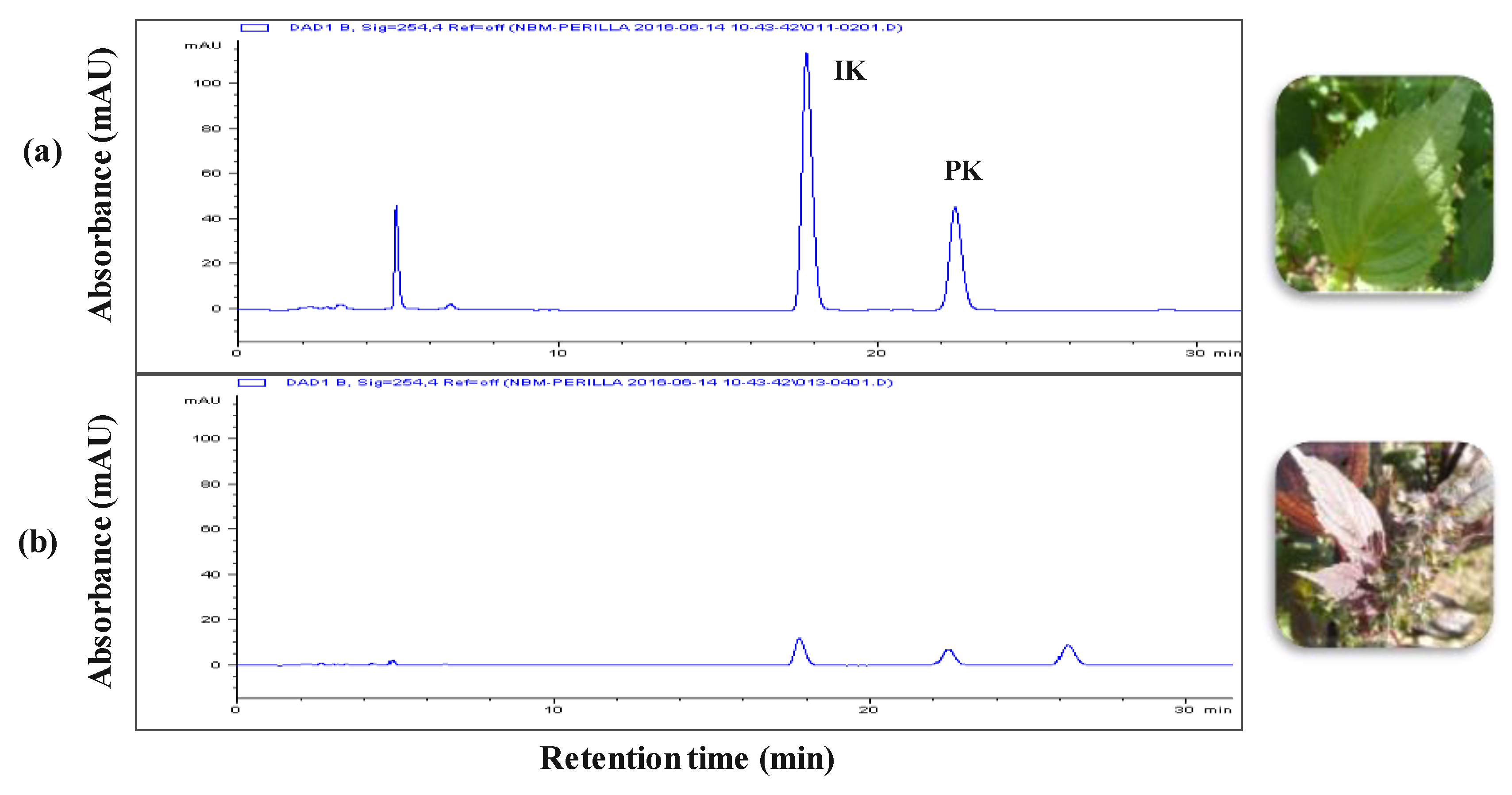
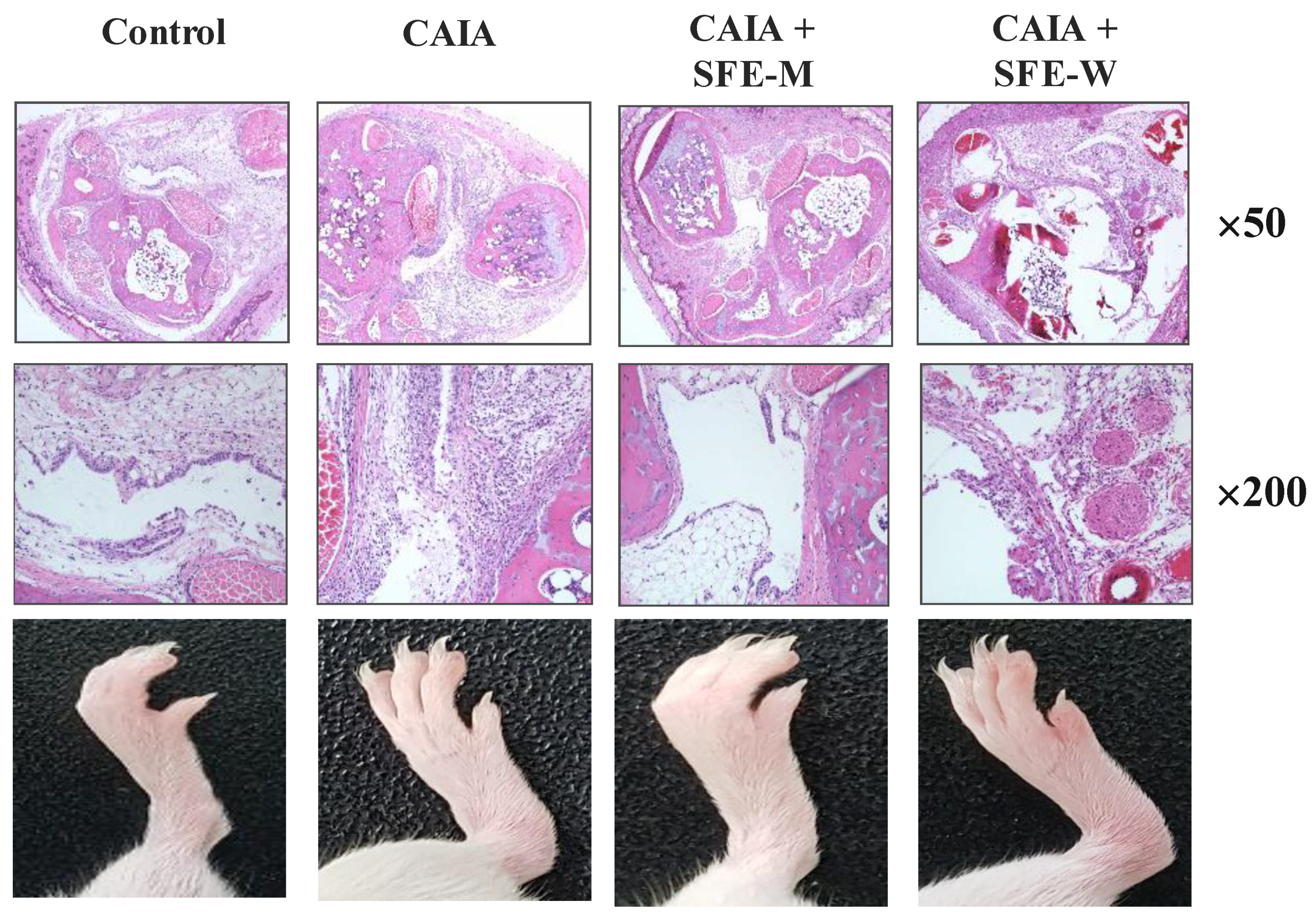
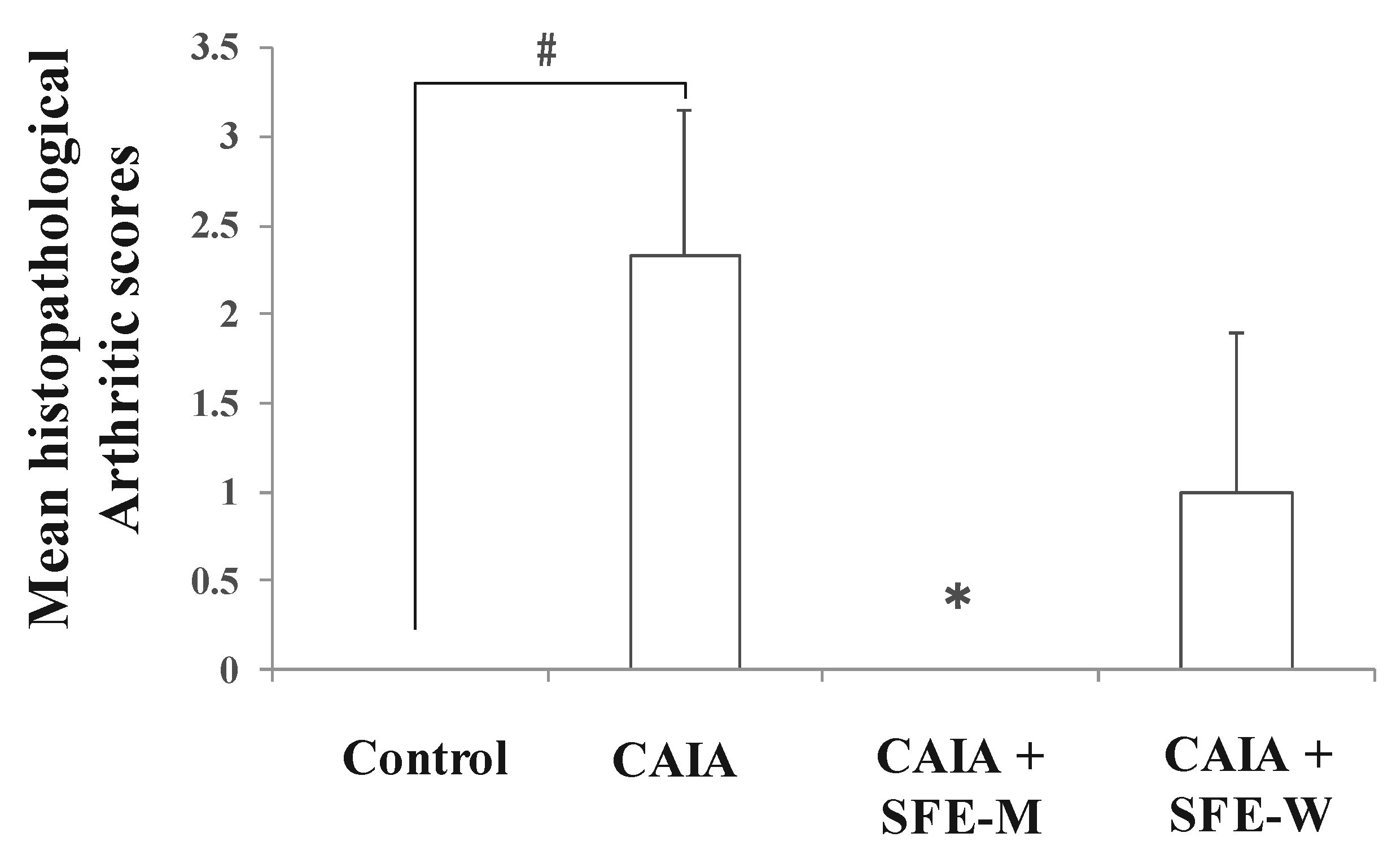
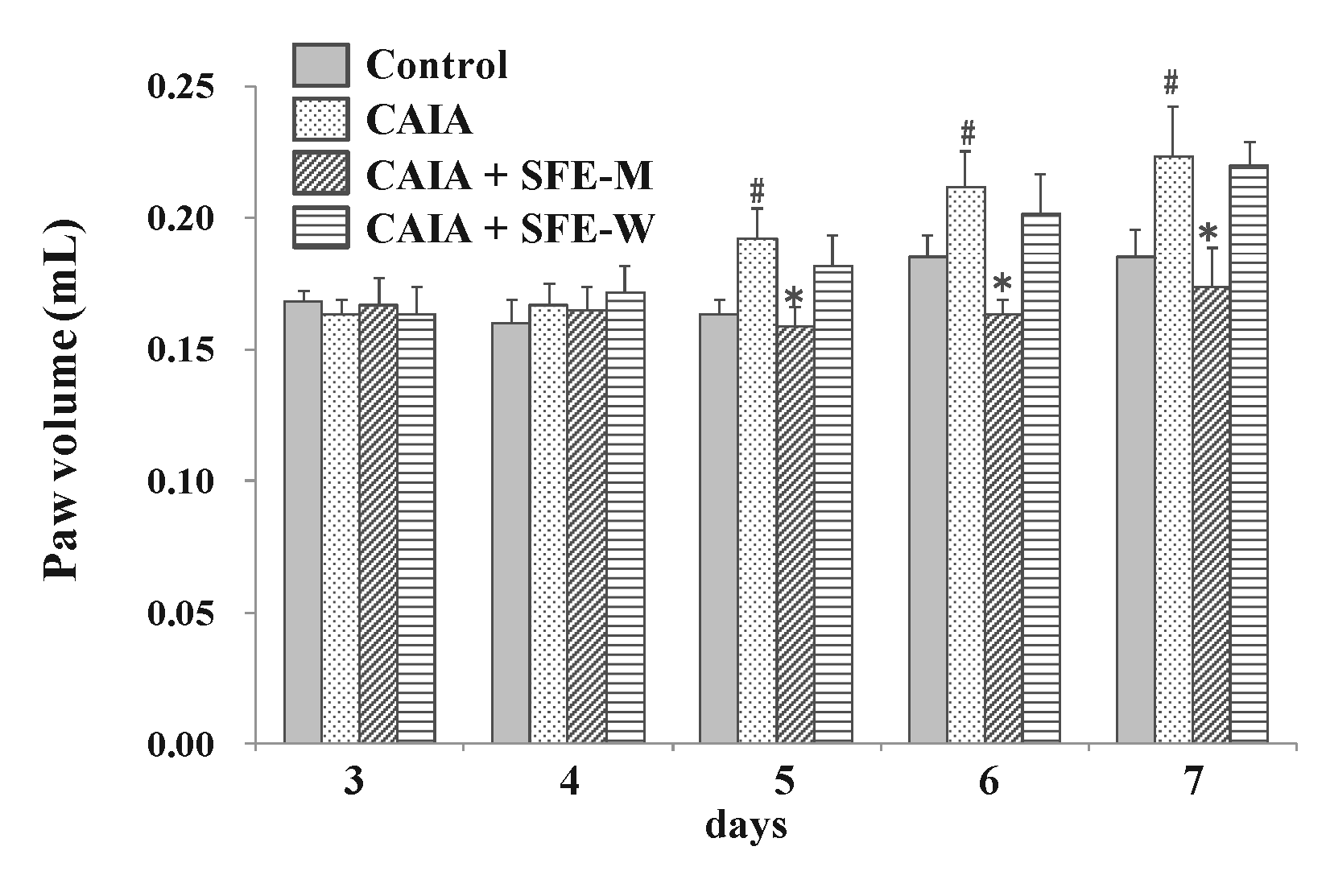
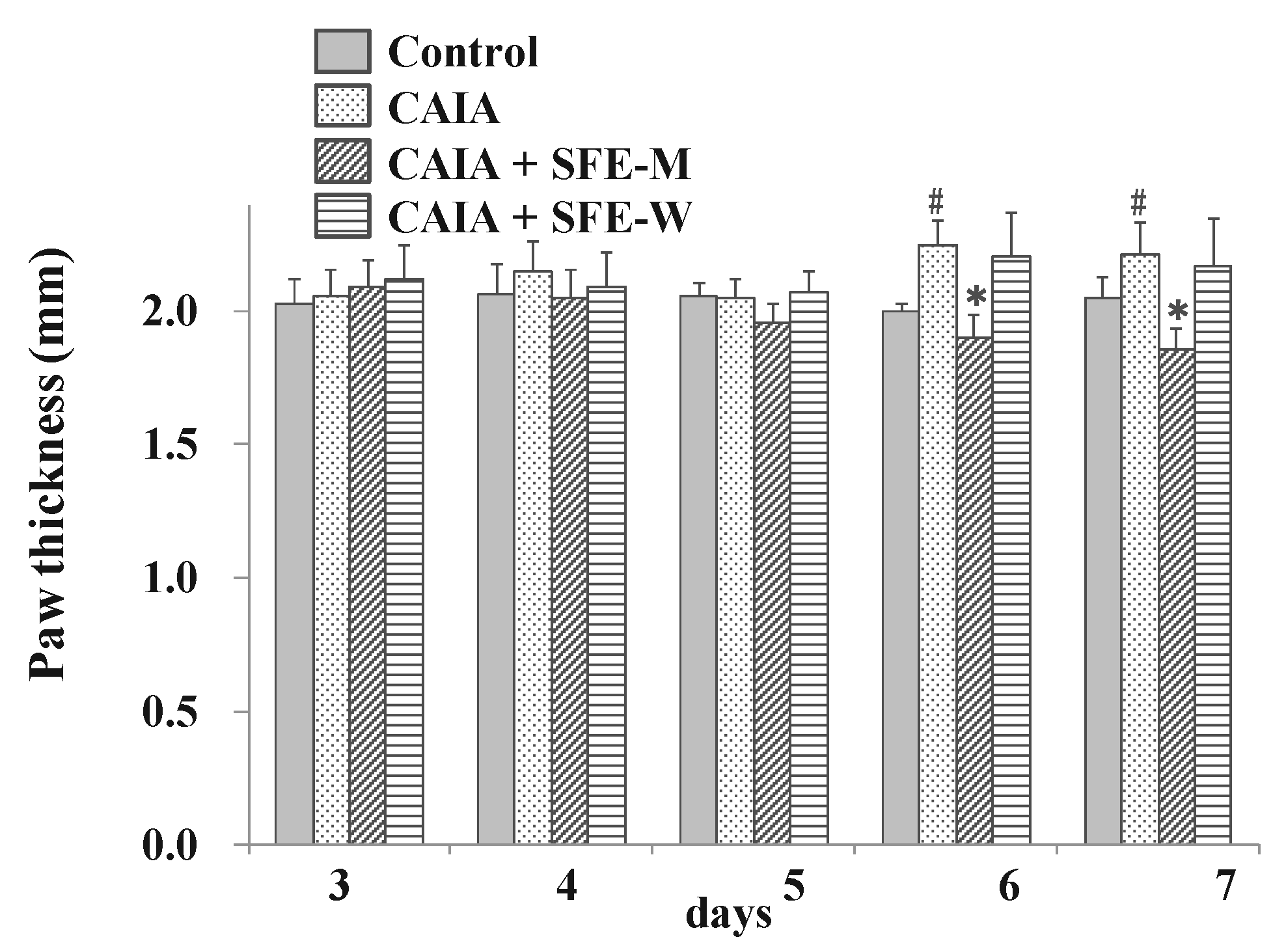
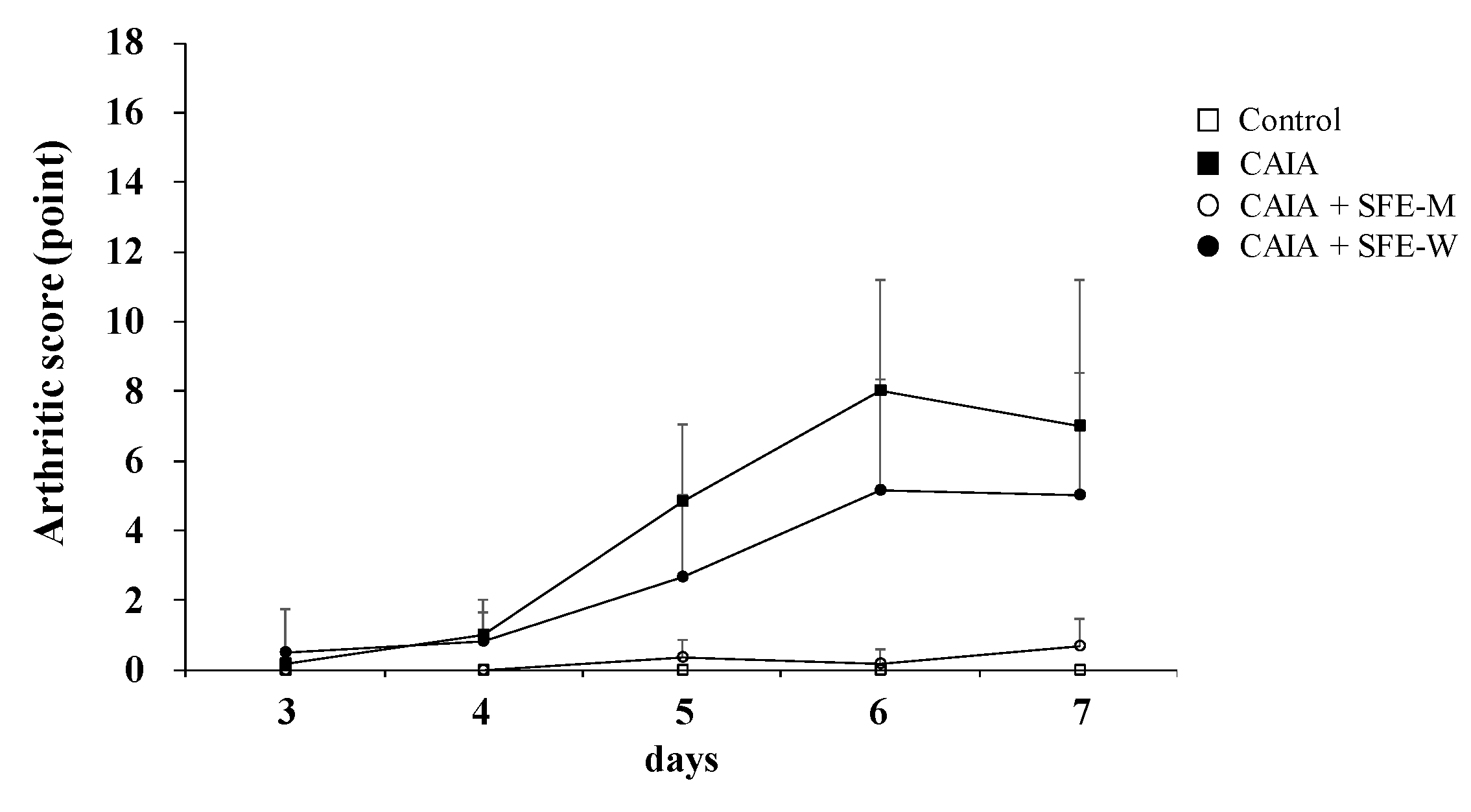

| Organ | Group | Control | CAIA | CAIA + SFE-M | CAIA + SFE-W | |
|---|---|---|---|---|---|---|
| Ankle joint | Inflammation | - | 6 | 0 | 6 | 2 |
| ± | 0 | 1 | 0 | 2 | ||
| + | 0 | 2 | 0 | 2 | ||
| ++ | 0 | 3 | 0 | 0 | ||
| +++ | 0 | 0 | 0 | 0 |
© 2019 by the authors. Licensee MDPI, Basel, Switzerland. This article is an open access article distributed under the terms and conditions of the Creative Commons Attribution (CC BY) license (http://creativecommons.org/licenses/by/4.0/).
Share and Cite
Jin, C.H.; So, Y.; Kim, H.-Y.; Han, S.N.; Kim, J.-B. Anti-Arthritic Activities of Supercritical Carbon Dioxide Extract Derived from Radiation Mutant Perilla Frutescens Var. Crispa in Collagen Antibody-Induced Arthritis. Nutrients 2019, 11, 2959. https://doi.org/10.3390/nu11122959
Jin CH, So Y, Kim H-Y, Han SN, Kim J-B. Anti-Arthritic Activities of Supercritical Carbon Dioxide Extract Derived from Radiation Mutant Perilla Frutescens Var. Crispa in Collagen Antibody-Induced Arthritis. Nutrients. 2019; 11(12):2959. https://doi.org/10.3390/nu11122959
Chicago/Turabian StyleJin, Chang Hyun, Yangkang So, Hyo-Young Kim, Sung Nim Han, and Jin-Baek Kim. 2019. "Anti-Arthritic Activities of Supercritical Carbon Dioxide Extract Derived from Radiation Mutant Perilla Frutescens Var. Crispa in Collagen Antibody-Induced Arthritis" Nutrients 11, no. 12: 2959. https://doi.org/10.3390/nu11122959





